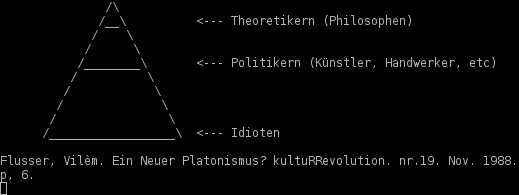12
06/15
14:46
idiots, hand workers, philosophers
According to Vilém Flusser, Plato establishes three possible relations between us and the world of the Ideas. First, we cannot remember the Ideas and therefore staying in the world of appearances. He calls those in this sort of relation: the idiots. In case the we do remember the Idea, there are two options. First, we could press the ideas out of the appearances and become hand workers or artists, politicians in Plato terms. Or second, we could turn and look directly at the ideas in which case we become theoreticians, philosophers in Plato. Plato mistrusted the artists of the politicians because in their handling of the appearance, the emerging idea is any the original pure Idea. It is a distortion. Their handling prevents access to the Idea as such by presenting a simulation. That way it is explained the hatred some monotheistic religions have to images.
In a cybernetic fashion, Flusser presents us a contemporary example of image creation. Someone thinks a space and atemporal ideas, he then codes them into a computer and this in turn produces an image that corresponds to the pure idea he had thought. This is a pure image of the pure idea because it is based on various technical codes such as a Cartesian coordinate system and symbolic operations with numbers. The image then turns into drawings and plans for an aeroplane that a series of automatic robots build.
Plato would take the person thinking the image and sitting in front of a computer as a true philosopher because these images are pure theory. They are processes of thought not or representation. The computer and the robot merely substitute for the hand workers. And those who pay and trust their lives to what the robots have built are the idiots.
If the person’s interest lies exclusively on the theoretical beauty and the process of thought of the image, he or she might be then a philosopher or a pure artists. Someone who has access the second degree of imagination brought by the technical images. This pure artist does not seek to imagine a particular aeroplane or any contrete entity. Her or his focus is exclusively on the abstract idea. There is no imitation nor simulacrum. Others, the politicians or in a more contemporary accent, the robots, would take this image-idea and imitate it and use it as a model. This pure artist experiences the pure idea, while the robots only try to press an appearance out the idea, whether it is an aeroplane or anything else.
- Flusser, Vilém. Ein neuer Platonismus?. In kulturRevolution: modelle von gehirn und seele. Nr.19. November 1998. Klartext Verlag, Deutschland.
